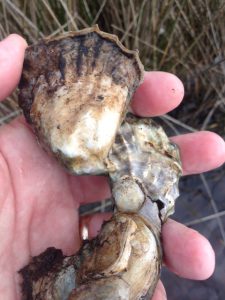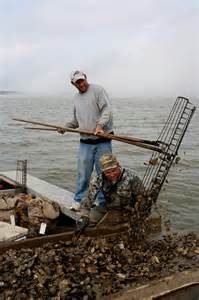Most ecosystems are named for the dominate plant in the system – marsh, meadow, swamp, forest, etc. But reefs are typically named by the dominate animal – coral, oyster, etc.

Everyone knows the oyster. You either first met them because parents told you to be careful or you will cut yourself on them, or you DID cut yourself on them. And of course, many are first introduced to the animal at a local restaurant, it is one of the more popular seafood species in the south for sure.
They are a bivalve mollusk, producing their characteristic calcium carbonate shell from minerals they absorb from the estuarine environment. Both valves are hinged near the umbo and grow sort of elongated, one valve being flat, the other bowl-shaped where the bulk of the animal resides. Like most mollusk, they begin their lives as microscopic veligers drifting with the plankton and then quickly forming their shells and settling on the bottom as spat. They differ from some bivalves in that once on the bottom they will cement themselves and remain there the rest of their lives – they are sessile (they do not move). Because of this cementing process they must settle out on a hard substrate. More often than not, this is another oyster, but as we all know – they will settle on a lot of things. Rocks, pilings, docks, boats, sunken cans and coolers, you name it!

Photo: Florida Sea Grant
The typical oyster will form a “clump” of oysters cemented together and these clumps cement together forming an oyster bar or oyster reef. The reef is usually elongated due to the currents oysters love causing this growth pattern to happen. They could be several hundreds of feet long, maybe thousands, and several feet high. Oysters can tolerate being out of the water for a little bit, by closing their shells until the tides rises again, but it is rare to see an oyster reef above the surface at high tide.
Oysters are hermaphroditic, switching between being male and female. The reproductive cycle begins with the warming of the water in spring. At 86°F some of the males will release a pheromone (hormone that is released outside of the body instead of inside) which triggers other males and the females to release their gametes. Since fertilization is external, and oysters are sessile, this mass spawning increases the chance for the gametes to find each other and for fertilization to be successful.
As mentioned, the first stage of a fertilized oyster is planktonic – the veliger. Being planktonic these veligers ride the currents and tides where they may go. If the tide and winds are pushing the water towards the mouth of the bay, the spat will settle out in more saline waters. Here they will have to first find suitable substrate to attach and then avoid the oyster drill. Most do not and, again, we do not see many oyster reefs in this part of the bay. It has been found that some adult oyster can release pheromones that trigger the spat to settle early before they are pushed towards either the sea or the rivers, and have the best chance of surviving as well as contributing to the building of the reef.

Photo: UF IFAS
Looking at how the environment impacts the life and the life impacting the environment. We would start with the substrate needed for oyster reefs to form. Though they can tolerate growing in high saline water, such as the Gulf of Mexico, they rarely do. This is primarily due to predation. Sea stars and a snail called the oyster drill (Stramonita haemastoma) are known to consume oysters. Being sessile, they have no real defense other than growing where these predators are not – and that is in the low saline waters of the upper estuaries.
Being sessile filter feeders, they prefer stronger currents to bring them food, and because of this (and there is nothing to cement to) muddy bottoms are not where they usually begin life. However, once the reef begins to form the currents change, water slows, and muddy bottoms do form around. Excessive sedimentation can literally bury them but that hard base will be the foundation for new recruits and the reef continues to exist.
Oysters can filter up to 50 gallons of water an hour removing food and suspended solids which actually improves water clarity of the turbid currents coming from the rivers. This improved water quality helps support meadows of seagrass we mentioned in Marine Ecology Lesson 3. This is one way the reef impacts the surrounding environment. Another is to provide an oasis for living creatures who would otherwise have to deal with predators in open sand or mud habitats of the upper estuary.
Sponges and anemones are themselves sessile and find a suitable habitat attached, or bored into, the oysters. There are numerous species of worms include the serpulid worms who produce hard calcium tubes attached to the oysters and extend tree-like limbs into the water to help filter feed as well. Several species of polychaete worms move in and around the reef feeding on detritus removing debris and waste from the community – the garbage cleaners. These worms can sometimes be found when you shuck and oyster. At first this appears gross but then you realize that actually the oyster is probably much cleaner having them there. So, you just remove them and get on with your meal! One species of flatworm, Stylochus is a predator of the oyster and is known as the “oyster leech”.
Mussels are another type of sessile molluscan bivalve but attaches using stringy byssal threads instead of cement. They compete with the young oysters for space on the reef when settling out. A high abundance of mussels sometimes indicates a problem for oyster settlement and a problem for the reef in general. There are numerous snails, and crabs who will live here – some are predators. It has been said there may be over 1000 mud crabs / yard2 on an oyster reef. Blue crabs and stone crabs are also found.
Echinoderms can be problems for oysters but they, again, require a high salinity (near 30‰) and so are not common where most oyster reefs are doing well.
As you might think, fish love these reefs. Some for hiding places – such as blennies, gobies, and skillet fish – and others to feed on the rich amount of food found here – such as gray snappers, sheepshead, and pinfish.
Few people pay attention to this estuarine habitat other than as a source of food for themselves, but it has been reported that the biological richness of the oyster reef may be higher than both the salt marsh and seagrass meadows. They are fascinating places.
ACTIVITIES
- Explore an oyster. You can do this by visiting your local seafood market and buying some. Take them home, place them a pan, and examine the different creatures that are attached to their shells – NOTE: cultured oysters may have clean shells since they are not grown on reefs. Make a list of all the cool creatures you find. Afterwards take an oyster knife and open your oyster to see what the creature looks like. And, if you wish, place them on a cracker with some hot sauce and enjoy a great seafood item!
- Visit an oyster reef. You must do this with gloves and very good shoes. Oysters are notorious for cutting hands and feet and can leave nasty wounds. You might find a small clump of oysters which you can transfer to a bucket you have brought with you. Shake this to see what sorts of creatures fall out.
- Visit a local aquarium that provides an oyster reef exhibit. These exhibits do a good job showing you the world of the oyster reef.
 0
0
